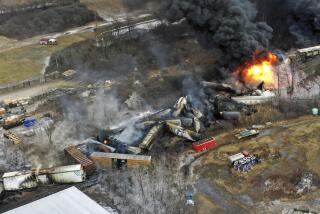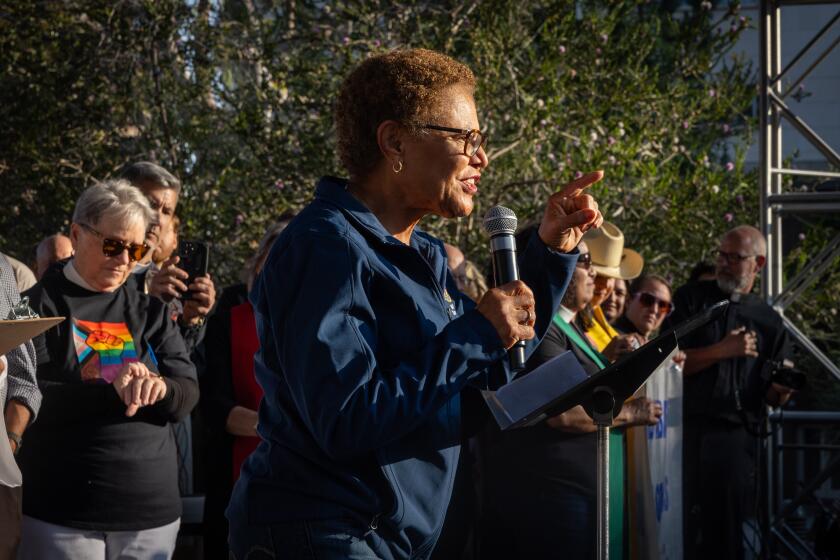Engineer Blames Crash on Brakes
- Share via
SAN BERNARDINO — Speaking from his wheelchair Tuesday in calm, measured tones, locomotive engineer Lester Foster described the Feb. 1 crash of a runaway freight train in the Cajon Pass that killed two fellow crew members.
Foster said that although he applied the air brakes as the heavily laden train began descending the steep, 24-mile grade, “we started gaining a little speed. . . .”
“I gave it a little more air . . . but we continued to gain speed,” he said. “I put the train into full emergency [braking], but it continued to gain . . . 40 mph . . . then 45 mph. . . .
“The last I can recall, we were doing about 65 when we passed under Interstate 15.”
Seconds later, as the Burlington Northern Santa Fe train entered a curve at more than four times the authorized speed, it hurtled from the rails and exploded in flames, killing the conductor and a trainman and leaving Foster pinned in the wreckage with a broken back.
Although the cause of the crash has not been determined officially, Tuesday’s testimony by Foster and other witnesses at a National Transportation Safety Board hearing supported increasing evidence that the accident occurred because the main brake air line was blocked--possibly when an air hose became pinched between two cars.
Initial suspicions of sabotage have been replaced by a growing belief that as the freight cars bunched together after the train crested the summit, one of the hoses between the cars was squeezed closed.
When that happens, the engineer has only partial use of the air brakes. Those between the locomotive and the blockage can still be applied, but those beyond it cannot unless the train is equipped with a special radio-powered remote-control device at the back of the train.
Foster’s train had such a device, but--as testimony confirmed Tuesday--the device had not been armed. On Feb. 1, when the accident occurred, there was no mandate by either the railroad or the Federal Railroad Administration requiring freight trains to be equipped with the devices, even though they were in widespread use.
Foster testified that although he knew the device was not working when he started down the grade, he decided to proceed anyway. Investigators say that with part of the air brake system out of commission, Foster’s train was doomed to crash on the long, twisting downgrade.
NTSB Chairman Jim Hall says the wreck is one of at least 10 during the last three years that could have been prevented if the trains had been equipped with working remote control devices.
Five days after the crash that injured Lester and killed his crew mates, conductor Gilberto Luis Ortiz and crewman Kevin Williams, the railroad agency issued an emergency order requiring that all Burlington Northern Santa Fe trains descending through the Cajon Pass gorge be equipped with working remote control devices.
On Feb. 22, the nation’s 10 largest railroads agreed to place the devices on all trains operating on mountain grades by Dec. 15. The railroads agreed to the installation of the devices on “virtually all” freight trains operating anywhere in the nation by June 30, 1997.
Foster, who was pulled from the wreckage of the crash by passersby and spent several weeks in a hospital before beginning his rehabilitation program, testified that he had never received any formal training in the use of the remote control device.
He said he was given a pamphlet on the subject and talked about it informally with a supervisor. “We learned about it on our own,” Foster said.
He said he never checked to see if the device was working before the train left Barstow and said company rules did not require him to do so. But he said that tests he performed before reaching the summit of Cajon Pass showed that the device was not working.
The engineer said he tested the train’s brakes before starting downgrade and they appeared to be working properly. Investigators say the blockage apparently occurred as the train started downhill.
NTSB officials said a “black box” recorder recovered from the wreckage of Foster’s locomotive appears to support the engineer’s account of what happened.
“We know you did all you could have done to stop that train,” Bud Davis, an official with the Brotherhood of Railway Carmen, told Foster. “You did almost heroic things.”
More to Read
Sign up for Essential California
The most important California stories and recommendations in your inbox every morning.
You may occasionally receive promotional content from the Los Angeles Times.













